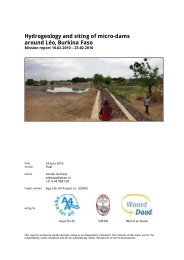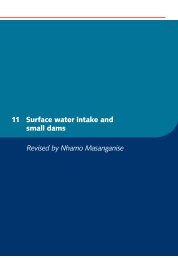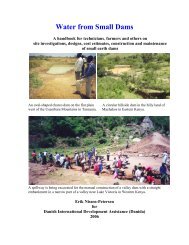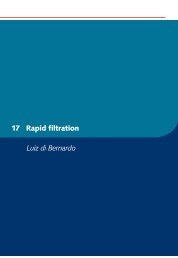Evaluation of the implementation of the solar still ... - SamSamWater
Evaluation of the implementation of the solar still ... - SamSamWater
Evaluation of the implementation of the solar still ... - SamSamWater
Create successful ePaper yourself
Turn your PDF publications into a flip-book with our unique Google optimized e-Paper software.
Evaporation (m3/d)As expected <strong>the</strong> evaporation from <strong>the</strong> berkads has a similar pattern to that <strong>of</strong> <strong>the</strong> general evapotranspiration in<strong>the</strong> area. In both it is visible how <strong>the</strong> evaporation is <strong>the</strong> highest in <strong>the</strong> dry months, and it is exactly in thosemonths that <strong>the</strong> collected water in <strong>the</strong> berkads is needed <strong>the</strong> most. Preventing it from evaporating is a significantgain.3.0Average daily evaporation loss from berkads2.52.01.51.00.50.0Jan Feb Mar Apr May June July Aug Sep Oct NovMonthFigure 3. Daily evaporation loss from berkads (m 3 /d).Solar di<strong>still</strong>ation systemsSolar water di<strong>still</strong>ation is a simple, yet effective, technology that has long been used to provide potable water inmany remote areas <strong>of</strong> arid and semi-arid developing countries (Hanson et al., 2004 and Flendrig et al., 2009).The first known use <strong>of</strong> <strong>solar</strong> <strong>still</strong>s dates back to <strong>the</strong> 16 th century, when Arab alchemist used this system to distilwater on a small scale (Malik et al., 1982). The first large-scale <strong>solar</strong> <strong>still</strong> plant was build at <strong>the</strong> end <strong>of</strong> <strong>the</strong> 19 thcentury in Nor<strong>the</strong>rn Chile, where a 4460 m 2 basin was providing 22.5 m 3 d -1 <strong>of</strong> fresh water (Malik et al., 1982).After that <strong>the</strong> most significant step in <strong>the</strong> development <strong>of</strong> <strong>solar</strong> <strong>still</strong>s has been <strong>the</strong> design <strong>of</strong> a small scaleinflatable plastic <strong>still</strong> used by <strong>the</strong> United States armed forces after World War II (Malik et al., 1982 and Howeand Tliemat, 1977). Since <strong>the</strong>n, several <strong>solar</strong> di<strong>still</strong>ation systems have been developed, patents have beengranted and papers have been published (Kabeel and El-Agouz, 2011; Flendrig et al., 2009; Tiwari et al., 2003).The principleThe basic principle behind <strong>solar</strong> di<strong>still</strong>ation is simple and replicates <strong>the</strong> natural process <strong>of</strong> water purification(Badran, 2007). A <strong>solar</strong> <strong>still</strong> is an air tight basin that contains saline or contaminated water (i.e. feed water). It isenclosed by a transparent top cover, usually <strong>of</strong> glass or plastic, which allows incident <strong>solar</strong> radiation to passthrough. The inner surface <strong>of</strong> <strong>the</strong> basin is usually blackened to increase <strong>the</strong> efficiency <strong>of</strong> <strong>the</strong> system byabsorbing more <strong>of</strong> <strong>the</strong> incident <strong>solar</strong> radiation (Tiwari et al., 2003). The feed water heats up, <strong>the</strong>n starts toevaporate and subsequently condenses on <strong>the</strong> inside <strong>of</strong> <strong>the</strong> top cover, which is at a lower temperature as it is incontact with <strong>the</strong> ambient air. The condensed water (i.e. <strong>the</strong> di<strong>still</strong>ate) trickles down <strong>the</strong> cover and is collected inan interior trough and <strong>the</strong>n stored in a separate basin (Al-Hayek and Badran, 2004 and Tiwari et al., 2003). Thissystem is also known as passive <strong>solar</strong> <strong>still</strong>, as it operates solely on sun‟s radiation (Figure 4) (KalidasaMurugavel et al., 2008).From a radiative point <strong>of</strong> view <strong>the</strong> following happens inside <strong>the</strong> di<strong>still</strong>er unit: <strong>the</strong> part <strong>of</strong> <strong>the</strong> <strong>solar</strong> radiationthat is not reflected nor absorbed by <strong>the</strong> cover is transmitted inside <strong>the</strong> <strong>solar</strong> <strong>still</strong>, where it is fur<strong>the</strong>red reflectedand absorbed by <strong>the</strong> water mass (Tiwari and Singh, 2004). The amount <strong>of</strong> <strong>solar</strong> radiation that is absorbed is afunction <strong>of</strong> <strong>the</strong> absorptivity and depth <strong>of</strong> <strong>the</strong> water. The remaining energy eventually reaches <strong>the</strong> blackenedbasin liner, where it is mostly absorbed and converted into <strong>the</strong>rmal energy (Tiwari and Singh, 2004). Some <strong>of</strong>7
















